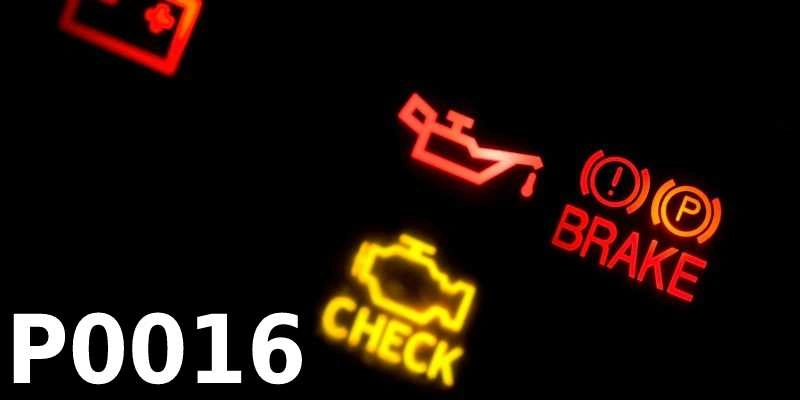What Does Error P0016 Mean? And How to Fix It

What Does Error P0016 Mean? And How to Fix It
The P0016 fault code is one of the more common errors you might encounter in modern cars, and it should always be taken seriously. This code indicates a synchronization mismatch between the crankshaft and camshaft sensors, which directly affects engine operation. Below I’ll explain what P0016 means, its symptoms and causes, and how you can diagnose and remedy it.
What is error P0016, and when does it occur?
Error code P0016 signals a misalignment in the signals coming from:
-
the crankshaft position sensor (CKP), and
-
the camshaft position sensor (CMP).
In other words, the engine control unit (ECU) has detected that the crankshaft and the camshaft are not synchronized correctly. This synchronization is vital because it determines the correct opening and closing of valves and the timing of fuel injection.
This error most often shows up in engines with variable valve timing systems (such as VVT, VANOS, VVT-i, etc.). However, it can also occur in engines without such systems if the timing chain has stretched, the timing belt has skipped a tooth, or if the sensors themselves are faulty. Typically, the Check Engine light will turn on after multiple failed attempts by the ECU to align the readings.
Because P0016 indicates a serious disruption in engine timing, it always requires diagnostic attention — ignoring it can lead to more severe engine problems.
Symptoms that often accompany P0016
It’s rare for P0016 to be silent. Drivers frequently report:
-
Difficulty starting the engine (cold or warm)
-
Rough idling, stalling, or hesitation during acceleration
-
Loss of power or sluggish throttle response
-
The engine entering “limp mode” (reduced performance)
-
Increased fuel consumption
-
Noticeable vibrations during driving
-
Illuminated Check Engine light (sometimes with extra timing warnings)
-
In worst cases: engine may refuse to run altogether
These symptoms should not be ignored: P0016 is not just a nuisance, but a real risk to the timing system and internal engine parts.
Common causes of error P0016
Several root causes can lead to P0016 being triggered. Some of the most frequent are:
-
Stretched or worn timing chain — Over time, the chain may elongate and lose precise timing, causing a mismatch between sensor signals.
-
Skipped timing belt tooth — If the belt jumps a tooth on either the crank or cam pulley, it throws off the valve timing.
-
Faulty or dirty CKP / CMP sensors — If either sensor is damaged, dirty, misaligned, or has wiring issues, the ECU receives incorrect data.
-
Problems in the variable valve timing (VVT) system — A clogged oil control valve, a stuck actuator, or faulty cam phasers can disrupt synchronization.
-
Low or dirty engine oil — Clean oil at correct pressure is vital for VVT engines. Old or contaminated oil can clog oil channels and affect timing.
-
Electrical issues — Loose connectors, corrosion on pins, or damaged wiring can interfere with sensor signals.
Because the error often lies in the timing or sensor systems, thorough diagnostics are needed to pinpoint the exact cause.
Can you keep driving with error P0016?
Driving with P0016 is strongly discouraged. Since the code means the camshaft and crankshaft are out of sync, continuing to drive risks:
-
Further degradation of engine performance
-
Higher fuel consumption
-
Damage to valves, pistons, or other internal parts
-
Car entering “limp mode,” limiting performance
-
In extreme cases: complete engine failure
It may be possible to drive a short distance to reach a repair shop, but prolonged use with P0016 active can lead to very expensive damage.
DIY diagnosis: step-by-step for P0016
Before heading to a mechanic, you can attempt some preliminary checks:
-
Prepare tools — OBD-II scanner, flashlight, gloves, electrical contact cleaner, and proper engine oil.
-
Safety first — If oil pressure is low, the engine is noisy, or power drops dramatically, don’t drive further — call for towing.
-
Read error codes — Use your scanner to read stored codes. Note freeze-frame data like RPM, temperature, and speed.
-
Check engine oil — Inspect level and quality. Top up if low; replace if dirty or overdue.
-
Clear and test — Erase codes, then drive gently for 5–10 km. If P0016 doesn’t return, it may have been minor. If it does, deeper checks are needed.
-
Inspect sensor connectors — Look for loose, corroded, or oily plugs at the CKP and CMP sensors. Clean and reconnect.
-
Check wiring harness — Look for cracked insulation, broken clips, or chafed wires. Repair if necessary.
-
Listen for timing chain/belt noise — Rattling or slapping noises often mean chain or belt wear.
-
Check battery/charging system — Weak voltage can confuse sensor readings.
-
Review maintenance history — If the timing belt/chain service is overdue, consider replacement immediately.
Possible repairs to clear P0016
The right fix depends on the root cause:
-
Timing chain replacement — Chain, guides, and tensioners if stretched or worn.
-
Timing belt replacement — Belt, pulleys, rollers, and water pump if skipped or aged.
-
Sensor replacement — Crankshaft or camshaft position sensors, plus cleaning connectors.
-
Wiring repairs — Replace damaged wires or connectors.
-
VVT repairs — Clean or replace solenoid/actuator, flush oil passages.
-
Oil service — Change oil and filter to restore proper lubrication and VVT function.
-
ECU update/repair — Rarely, reflashing or ECU replacement may be required.
Because this code often reappears if only the symptom is fixed (not the root cause), a thorough inspection and proper repair are essential.
